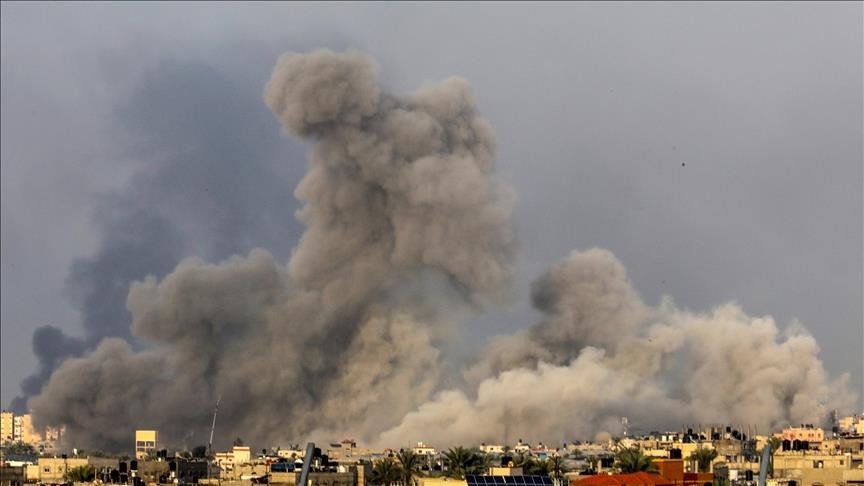Ramzy Baroud
“A year of combat”—this is how Israel’s new Chief of Staff, Eyal Zamir, described 2025 at a conference organized by the Israeli ministry of defense.
The exact sentence, translated from Hebrew, was: “The year 2025 will continue to be a year of combat.” The word ‘continue’ is crucial, suggesting that Israel will resume its wars, despite ceasefire agreements signed with the Lebanese government in November and Palestinian groups in January. In other words, it seems that Zamir is signaling that Israel will reopen these two fronts, even in the face of ceasefire deals.
Despite Israel’s insatiable appetite for war, it is hard to imagine what the Israeli army could achieve through renewed violence when it has already failed to accomplish its objectives in nearly 14 months in Lebanon and over 15 months in Gaza.
Israel launched thousands of airstrikes on Lebanon, destroying entire towns and villages and killing and wounding thousands. It also dropped over 85,000 tons of bombs on Gaza, leading to the unprecedented genocide and the killing and wounding of over 170,000. Despite this, Israel has failed on both fronts. In Gaza, as reported by Reuters, Hamas alone managed to recruit up to 15,000 fighters just before the end of Israel’s 471st day of relentless warfare.
Furthermore, the return of nearly one million Palestinians to northern Gaza has reset Israel’s so-called tactical or strategic achievements. These efforts, aimed at depopulating northern Gaza to create permanent military buffer zones, were reversed by the population’s return.
The war also came at a staggering cost to the Israeli army. Ironically, during the same ministry of defense conference, Zamir revealed the actual costs of Israel’s wars in the past year. He stated that the ministry “now provides care for 5,942 new bereaved family members,”, adding that the “Rehabilitation Department has taken in over 15,000 wounded service members, many bearing both physical and mental scars from the war.”
These figures were not broken down by category or war front and did not include casualties from October 7, 2023, to the end of the year. However, they represent the highest estimate of Israeli casualties provided to date, raising the question: Can Israel afford to return to war?
Former Israeli Defense Minister Yoav Gallant, who was dismissed by Prime Minister Benjamin Netanyahu on November 5, offered clues about Israel’s military crisis during an interview on Channel 12. Gallant recalled a conversation he had with Netanyahu after the Hamas assault on the Gaza Envelope region in southern Israel.
“The prime minister told me that we would see thousands of dead in the offensive in Gaza. I told him: We will not see thousands of dead,” Gallant said. Zamir’s numbers, however, have now validated Netanyahu’s estimates, not Gallant’s.
Another early fear of Netanyahu was that “Hezbollah will destroy everything if we hit it,” referring to the city of Tel Aviv. While that particular prediction did not fully materialize, the stalemate in Lebanon ensures Israel will remain haunted by similar fears.
So, will 2025 be a year of combat for Israel?
Netanyahu faces a twofold challenge: if all war fronts officially end, his government will collapse; but if he returns to active war, he will fail to claim any decisive victory.
It is possible that Zamir’s “year of combat” doctrine is aimed at saving face—projecting strength without reopening major war fronts. Israel may continue to create crises in Gaza and Lebanon without fully engaging in war, perhaps by delaying scheduled withdrawals, adding new demands, and so on.
But this may not be enough for Netanyahu to stay in power, especially in the face of growing dissatisfaction. This is where the Iron Wall, Israel’s ongoing military operation in the West Bank, comes into play.
Though Israel has launched numerous raids in the West Bank, the January 21 campaign was directly linked to the war in Gaza. It began two days after the latest ceasefire, signaling that a large deployment of Israeli forces in the West Bank was meant to offset reduced combat in Gaza.
It also served to distract from Israel’s sense of failure in Gaza, as described by Israeli National Security Minister Itamar Ben-Gvir, who quit Netanyahu’s coalition on January 19.
The war in the West Bank, centered in the refugee camp of Jenin, has used tactics similar to those employed in Gaza. Tens of thousands have been displaced from Jenin, Tulkarm, and other northern West Bank regions; hundreds have been killed, wounded, and had their homes demolished. The Israeli army seems to be attempting to compensate for its failure to ethnically cleanse Gaza by displacing entire communities in the West Bank.
If Israel persists in making 2025 a “year of combat” focused on the West Bank, the consequences could be dire, especially for an army that has already suffered unprecedented losses on multiple fronts.
If Israel continues on this path, an all-out uprising may become imminent, and new, unexpected fronts could open up simultaneously.
Israel must be reined in. It is acting like a wounded animal and, in doing so, it continues to kill Palestinians in the name of security while destabilizing the entire Middle East. Netanyahu must be stopped.
____________
Dr Ramzy Baroud is a journalist, author and the Editor of The Palestine Chronicle. He is the author of six books. He is a Non-resident Senior Research Fellow at the Center for Islam and Global Affairs (CIGA). His website is www.ramzybaroud.net

